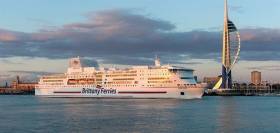Displaying items by tag: €17m 'Green' Technology
Brittany Ferries Invest €17m in 'Green' Technology on Pont-Aven
#CutEmissions - Brittany Ferries has invested €17 million to cut fuel emissions from its flagship Pont-Aven with the installation of exhaust gas cleaning systems.
As previously reported on Afloat, Pont-Aven is unique in that it is the only ferry operating in Irish waters in 2016 to be fitted with “scrubbers”, which dramatically reduce sulphur emissions to almost zero and significantly reduce particulate output.
Hugh Bruton, General Manager of Brittany Ferries Ireland said, “As a company, we have a profound respect for the environment and we have made a significant investment to ensure that our passengers will be travelling on the cleanest and most environmentally-friendly ship to operate in Irish waters this year. The installation of the scrubbers is just one of a number of steps that we have implemented as we strive to achieve sustainable tourism.”
The scrubbers were installed at the renowned Gdansk shipyard in Poland, before the commencement of the 2016 Cork-Roscoff sailing season earlier this month. The work on the Pont-Aven marks the completion of a major €80 million project over 18 months by Brittany Ferries to significantly improve the environmental performance of its six-strong car ferry fleet in Ireland and the UK.
Mike Bevens, Group Commercial Director at Brittany Ferries added, “Today we are still largely owned by the collective of French farmers who launched the company more than 40 years ago, with the aim of linking territories and improving trade. These aims have always been framed by a will to respect the environments in which we operate and this significant investment is testament to our on-going commitment.”
Brittany Ferries implements various measures to reduce the impact of its operations and to support organisations that promote conservation work including:
Cutting CO2 emissions while sailing
Brittany Ferries operations are planned to minimise fuel consumption, by reducing speed on overnight crossings. The effects of tides and the wind are also harnessed to optimise fuel efficiency.
Our water discharge policy
The Pont-Aven is fitted with water treatment units so that uncontaminated water is discharged to sea, and at a minimum of 12 nautical miles from the coast. Polluted water is stored on board, then discharged on shore, to be disposed of by certified waste disposal contractors.
Using anti-fouling paints
Brittany Ferries uses the latest silicon-based anti-fouling paints to coat the submerged parts of hulls. These are low in toxicity and also enhance flow through the water, aiding fuel efficiency and thereby reducing CO2.
Conservation work
The Pont-Aven is taking part in the longest running marine biological survey in the world, towing continuous plankton recorders (CPR) for SAHFOS. Brittany Ferries also works with whale and dolphin charity ORCA. Wildlife officers are hosted on the Pont-Aven throughout the summer to monitor and report on whale and dolphin sightings though the Bay of Biscay. This helps government fulfil its obligations under the Habitats Directive, but also supports conservation work to protect these beautiful sea creatures.
The Pont-Aven continues to offer the fastest direct ferry crossing from Ireland to France, taking just 14 hours and operating to a convenient weekend schedule. The state-of-the-art ship is the newest and most modern ship to be found on any direct crossing between Ireland and France. Passengers onboard enjoy unmatched cruise style standards and award-winning service and cuisine. Facilities include pool and bar areas with panoramic sea views, two cinemas, shopping malls, luxurious spa treatments and a wide range of restaurants, as well as complimentary Wi-Fi in all public areas of the ship.





























































